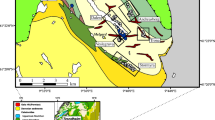Abstract
Trace element abundances in sulfides of these two large hydrothermal ore districts allow distinction of several groups of ore bodies with differing trace element levels. Within groups, certain elements show lateral or vertical zoning. The groups were deposited from different batches of ore fluid. The differences in trace element content between groups reflect differences in stage of differentiation or abundance of complexing species when the ore fluid separated from the magma. The zoning may result from “hydrothermal differentiation” of a single batch of ore fluid as it travels away from the magma. The zoning pattern correlates in part with expected strength of metal complexes, but also depends on temperature and solid-liquid partition coefficients.
Zusammenfassung
Auf Grund der Spurenelementhäufigkeiten in Sulfiden können in diesen beiden großen hydrothermalen Erzvorkommen mehrere Gruppen von Erzlagerstätten unterschieden werden. Innerhalb der Gruppen zeigen gewisse Elemente laterale oder vertikale zonale Verteilungen. Die Gruppen wurden von verschiedenen erzbringenden Lösungen gebildet. Die Unterschiede im Spurenelementgehalt zwischen verschiedenen Gruppen spiegeln Unterschiede im Stadium der Differentiation oder die Häufigkeit von komplexbildenden Ionen während der Absonderung der erzbringenden Lösungen von Magma wider. Die zonale Verteilung kann von der „hydrothermalen Differentiation“ einer einzigen erzbringenden Lösung auf ihrem Weg vom Magma herrühren. Teilweise entspricht die zonale Spurenelementverteilung der erwarteten Stabilität von Metalionenkomplexen, sie hängt aber auch von der Temperatur und von Verteilungskoeffizienten zwischen festen und flüssigen Phasen ab.
Similar content being viewed by others
References
Barnes, H. L.: Mechanisms of mineral zoning. Econ. Geol. 57, 30–37 (1962).
— Czamanske, G. K.: Solubilities and transport of ore minerals. In: Geochemistry of hydrothermal ore deposits, p. 334–381; ed. by H.L. Barnes. New York: Holt, Rinehart and Winston 1967.
Bethke, P. M., Barton, P. B.: Trace element distribution as an indicator of pressure and temperature of ore deposition (abst). Bull. Geol. Soc. Am. 70, 1569–1570 (1959).
Burnham, C. W.: Metallogenic provinces of Southwestern United States and northern Mexico. New Mexico, Bur. Mines Mineral Resources, Bull. 65 (1959).
— Hydrothermal fluids at the magmatic stage. In: Geochemistry of hydrothermal ore deposits, p. 34–74; ed. by H. L. Barnes. New York: Holt, Rinehart and Winston 1967.
Field, C. W.: Sulfur isotope abundance data, Bingham district, Utah. Econ. Geol. 61, 850–871 (1966).
Fleischer, M.: Minor elements in some sulfide minerals. Econ. Geol., 50th Ann. volume, 970–1024 (1955).
Helgeson, H. C.: Thermodynamics of hydrothermal systems at elevated temperatures and pressures. Am. J. Sci. 267, 729–804 (1969).
Hernon, R. M., Jones, W. R.: Ore deposits of the Central mining district, Grant County, New Mexico. In: Ore deposits of the United States, 1933–1967, p. 1211–1238; ed. by J. D. Ridge. New York: AIME 1968.
Hunt, R. N., Peacock, H.: Lead and lead-zinc ores of the Bingham district, Utah. In: Symposium on the geology, paragenesis and reserves of the ores of lead and zinc, p. 92–96, 18th Intl. Geol. Cong., London (1948).
Krauskopf, K. B.: The possible role of volatile metal compounds in ore genesis. Econ. Geol. 59, 22–45 (1964).
McIntire, W. L.: Trace element partition coefficients — a review of theory and applications to geology. Geochim. Cosmochim. Acta 27, 1209–1264 (1963).
Peters, W.C., James, A.H., Field, C.W.: Geology of the Bingham Canyon porphyry copper deposit, Utah. In: Geology of the porphyry copper deposits, p. 165–176; ed. by S. R. Titley and C. L. Hicks. Tucson: Univ. of Ariz. Press 1966.
Rose, A. W.: The iron content of sphalerite from the Central district, New Mexico and the Bingham district, Utah. Econ. Geol. 56, 1370–1384 (1961).
— Trace elements in sulfide minerals from the Central district, New Mexico and the Bingham district. Utah. Geochim. Cosmochim. Acta 31, 547–585 (1967).
— Baltosser, W. W.: The porphyry copper deposit at Santa Rita New Mexico. In: Geology of the porphyry copper deposits, p. 205–220; ed. by S. R. Titley and C. L. Hicks. Tucson: Univ. of Arizona Press 1966.
Stacey, J. S. Zartman, R. E., Nkomo, I. T.: A lead isotope study of galenas and selected feldspars from mining districts in Utah. Econ. Geol. 63, 796–814 (1968).
Toulmin, P., Clark, S. P.: Thermal aspects of ore formation. In: Geochemistry of hydrothermal ore deposits, p. 437–464; ed. by H. L. Barnes. New York: Holt, Rinehart and Winston 1967.
Wallace, S. R., Muncaster, N. K., Jonson, D. C., Mackenzie, W. B., Bookstrom, A. A., Surface, V. E.: Multiple intrusion and mineralization at Climax, Colorado. In: Ore deposits of the United States, 1933–1967, p. 605–640; ed. by J. D. Ridge. New York: AIME 1968.
Author information
Authors and Affiliations
Additional information
Contribution No. 69–34, College of Earth and Mineral Sciences, The Pennsylvania State University
Rights and permissions
About this article
Cite this article
Rose, A.W. Origin of trace element distribution patterns in sulfides of the central and bingham districts, western U.S.A.. Mineral. Deposita 5, 157–163 (1970). https://doi.org/10.1007/BF00208059
Issue Date:
DOI: https://doi.org/10.1007/BF00208059




